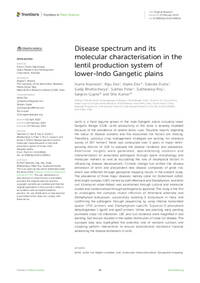Disease spectrum and its molecular characterisation in the lentil production system of lower-Indo Gangetic plains

Authors:
Lentil is a food legume grown in the Indo-Gangetic plains including lower Gangetic Bengal (LGB). Lentil productivity in this zone is severely impeded because of the prevalence of several biotic cues. Plausible reports regarding the status of disease scenario and the associated risk factors are missing. Therefore, judicious crop management strategies are lacking. An intensive survey of 267 farmers’ fields was conducted over 3 years in major lentil-growing districts of LGB to evaluate the disease incidence and prevalence. Additional insights were generated, apprehending isolation and characterisation of associated pathogens through spore morphology and molecular markers as well as elucidating the role of biophysical factors in influencing disease development. Climate change has shifted the disease dimension of lentil and precipitated new disease complexes of great risk, which was reflected through geospatial mapping results in the present study. The prevalence of three major diseases, namely collar rot (Sclerotium rolfsii), lentil blight complex (LBC) incited by both Alternaria and Stemphylium, and lentil rust (Uromyces viciae-fabae), was ascertained through cultural and molecular studies and contextualised through pathogenicity appraisal. This study is the first to investigate the complex mixed infection of Alternaria alternata and Stemphylium botryosum, successfully isolating S. botyrosum in India, and confirming the pathogens through sequencing by using internal transcribed spacer (ITS) primers and Stemphylium-specific Glycerol-3-phosphate dehydrogenase 1 (gpd1) and gpd2 primers. Unlike late planting, early planting promoted collar rot infestation. LBC and rust incidence were magnified in late planting. Soil texture resulted in the spatial distribution of collar rot disease. The surveyed data also highlighted the potential role of resistant cultivars and cropping pattern intervention to ensure associational resistance towards addressing the disease bottleneck in lentil.
